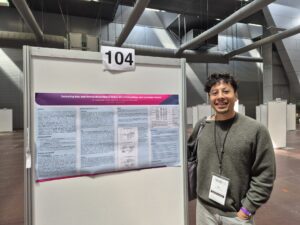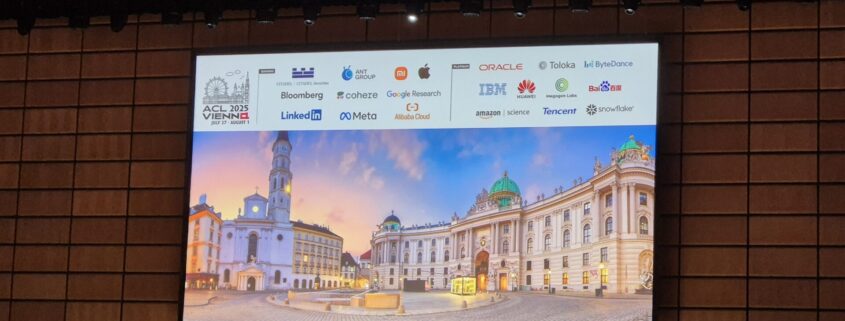BFH Applied Machine Intelligence at ACL 2025
The 63rd Annual Meeting of the Association for Computational Linguistics (ACL 2025) took place from July 27 to August 1, 2025, at the Austria Center Vienna. ACL is the world’s leading conference in the field of computational linguistics and natural language processing (NLP), bringing together researchers from academia and industry to present the latest advances in machine language understanding, translation, chatbots, and more.
This year’s main theme was the “Generalisation of NLP Models”, focusing on how AI systems can respond reliably and fairly to new, unseen data. The topic was explored through keynote talks, expert panels, and dedicated conference tracks. Following the main conference days, several workshops were held on specialized topics.
Workshop on Gender Bias in Natural Language Processing (GeNLP)
One of these workshops was of particular relevance for BFH researchers from the Applied Machine Intelligence research group and the BFH Generative AI Lab, working in the Horizon Europe project BIAS [1], offering in-depth discussions and collaboration opportunities on the topic of Gender Bias in NLP. In this year’s edition of the Gender Bias in Natural Language Processing (GeBNLP) workshop, the team presented a paper [2] with results from the BIAS project.
Language models and other technical representations of texts, like those used in chatbots or automatic translation tools, learn patterns from massive amounts of text found online. While this makes them powerful and versatile, it also means they can absorb and reproduce harmful stereotypes or social biases present in the data. For example, a language model might associate certain professions more strongly with one gender or show negative bias toward specific ethnic groups. Most research so far has focused on detecting and reducing these kinds of biases in English, and usually only looks at one type of bias, such as gender, at a time.
The presented paper takes a broader and more inclusive approach by examining both individual and overlapping (intersectional) biases in Italian language models. The researchers measured bias in Italian, including the definition of a method called GG-FISE, based on FISE [3], which accounts for the unique role of grammatical gender in the language. They also adapted existing English datasets and tests to suit Italian. Their experiments revealed clear biases in how certain ethnic and gender groups, particularly Romanian and South Asian communities, are represented. The findings underline the importance of designing culturally aware tools to better detect and address bias across different languages and social identities.

Workshop on BioNLP
The BioNLP workshop, organized by ACL in association with ACL SIGBioMed, has established itself as a leading venue for cutting-edge research in natural language processing (NLP) for the biomedical and clinical domains since 2002. It highlights the full spectrum of the field: from core NLP methodologies to impactful real-world applications in healthcare.
In the 2025 edition, several contributions are particularly relevant to researchers at the Bern University of Applied Sciences (BFH), especially those within our research team, the Applied Machine Intelligence Research Group, and the BFH Generative AI Lab.
One noteworthy paper, Converting Annotated Clinical Cases into Structured Case Report Forms [4], introduces a semi-automatic methodology for transforming annotated clinical narratives into structured Case Report Forms (CRFs). This approach, applied to the E3C dataset in both English and Italian. At BFH, we are keen to explore similar methodologies for structuring clinical data, particularly in the context of improving data usability for AI-driven applications.
Another highly relevant contribution is Enhancing Stress Detection on Social Media [5], which presents a novel multimodal framework combining textual data with synthesized visual cues to enhance stress detection accuracy. This aligns closely with our ongoing project titled Automatic Work-Related Stress Detection, which aims to develop a robust, multimodal machine learning framework for detecting and monitoring work-related stress, specifically among nurses.
Our current research focuses on two core objectives:
- Data Collection and Integration: We gather and synchronize data from various sources including:
- Physiological signals from wearable smartwatches (e.g., heart rate variability, sleep, and activity patterns)
- Unstructured clinical text, authored by participants within the clinical information system
- Daily self-assessments, using a 0–10 scale to quantify subjective stress levels based on three core statements
- Shift schedules, capturing workload distribution, work-rest ratios, and temporal patterns
- Multimodal Model Design and Evaluation: We aim to build machine learning models capable of capturing complex relationships across these diverse data modalities and linking them to indicators of stress.
To support this, we have adopted a longitudinal study design involving 24 nurses over an extended observation period. By employing repeated measurements, we enable a dynamic analysis of stress patterns over time.
References:
[2] Alexandre Puttick and Mascha Kurpicz-Briki. 2025. Detecting Bias and Intersectional Bias in Italian Word Embeddings and Language Models. In Proceedings of the 6th Workshop on Gender Bias in Natural Language Processing (GeBNLP), pages 33–51, Vienna, Austria. Association for Computational Linguistics.
Available at: https://aclanthology.org/2025.gebnlp-1.3/
[3] Tessa ES Charlesworth, Kshitish Ghate, Aylin Caliskan, and Mahzarin R Banaji. 2024. Extracting intersectional stereotypes from embeddings: Developing and validating the flexible intersectional stereotype extraction procedure. PNAS nexus, 3(3).
[4] Pietro Ferrazzi, Alberto Lavelli, and Bernardo Magnini. 2025. Converting Annotated Clinical Cases into Structured Case Report Forms. In Proceedings of the 24th Workshop on Biomedical Language Processing, pages 307–318, Viena, Austria. Association for Computational Linguistics.
[5] Efstathia Soufleri and Sophia Ananiadou. 2025. Enhancing Stress Detection on Social Media Through Multi-Modal Fusion of Text and Synthesized Visuals. In Proceedings of the 24th Workshop on Biomedical Language Processing, pages 34–43, Viena, Austria. Association for Computational Linguistics.
 Create PDF
Create PDF

 Contributions as RSS
Contributions as RSS Comments as RSS
Comments as RSS
Leave a Reply
Want to join the discussion?Feel free to contribute!